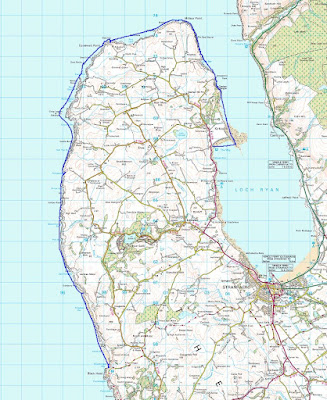
I have spent three weeks in the autumn of 2006 and the spring of 2007 paddling the Advanced Elements Advancedframe Kayak and Advancedframe Convertible Kayak on the Solway. They are innovative inflatable boats which use aluminium frames to give the bows and sterns a traditional kayak shape. They were supplied by Mike Thomson of Scottish Paddler Supplies. They share a packable design that can be unfolded from a suitcase sized bag and inflated within about 5 minutes using a two handed double action barrel pump.

180 kg of finely toned muscle can drive the Convertible Kayak up to a maximum of 10.4 km/hr, which is faster than some composite single seaters!

This is the one man Kayak version which I also tested in 2 foot waves and a force 5 wind. It surfed well but was blown about more than a conventional kayak. It was surprisingly rigid crossing steep waves. I was very impressed by its performance in these conditions. I am not saying that it is the ideal type of kayak to set out on a long trip in these conditions but it is great fun to use off the beach. I would also say that a competent kayaker would be quite happy to paddle home a fair distance, if caught out in these conditions.

The single Kayak version in comparison with the Valley Nordkapp LV. Side on to steep waves you do feel the boat rocking but it does not feel insecure. In contrast a narrow boat like the Nordkapp LV just bobs up and down with the waves from the beam.

A 9 and 6 year old were able to paddle the Convertible Kayak version for 1.5 miles with no previous experience. Despite their inexperience, it tracked well due to an inbuilt permanent skeg. Despite their diminutive size, they were able to turn it using sweep strokes.

The bow and stern are formed from cloth stretched over an aluminium frame giving a surprisingly fine entry for an inflatable boat. (Most inflatables) just have a big blunt round tube. In rough water the bow cut cleanly through the waves. In calm water the fine stern meant there was little visible wake behind the boat which is a sign of an easily driven hull.

Standard on the one man Kayak , and an option on the longer Convertible Kayak , is a deck with an inflatable rim that will take a spray deck. The seat base and back are comfortable and in the convertible you can have two (fore and aft) or one (mid) seat positions with zip on decks available for each option. There is also an adjustable inflatable footrest. There is a puncture repair kit in the seat back pocket.

There is a continuous air chamber which runs right round the boat. Inside this are two separate air bladders, so if one punctures you still have air right round both sides of the boat. Three layers of cloth contain the air. The hull has excellent longitudinal stiffness and I suspect that the two bladders within the one air chamber contribute to this stiffness. The materials and finish are superb, it just oozes quality. It can carry a lot of gear in dry bags below the deck, it has lots of lashing points and deck elastics. It has decent carry handles and the assembly instructions are printed on a waterproof label tied to the rear handle. The boat can be completely deflated for easy packing by reversing the pump and using it to suck air out. If you have 4 piece paddles there is room for them in the carrying case.
A wide range of accessories are available. These include a full length bow to stern "backbone" to provide extra longitudinal stiffness. I did not test this and I found the stiffness to be very good in the shorter Kayak in rough conditions. The longer Convertible Kayak was only tested in flat water conditions without the backbone but it seemed to have very good stiffness when crossing speed boat wakes. For those requiring extra stiffness in more demanding conditions, the backbone is collapsible and fits in the carrier bag.
Both boats paddle very well in a wide range of conditions. These are most definitely not toys, they are serious sea kayaks. In calm conditions, I paddled the convertible, one up, for 12km with no discernible extra effort than a companion in a composite P&H Quest.
I think they would especially suit:
those with children
those who fly to destinations where it is difficult to hire
those who have no space to store a traditional kayak
yachtsmen who would like to explore from an anchorage
those who want to potter in all but the most exposed coastal environments
those who like snorkeling
they would undoubtedly make fantastically stable fishing platforms, though the thought of sharp hooks makes me reluctant to recommend any inflatable for this purpose. (It has to be said that many people fish safely from inflatable dinghies.)
I would thoroughly recommend either of these kayaks.
European distributor: Luftkajak
Advancedframe Kayak
Length: 318cm Width: 81cm Weight: 16 kg Carrying capacity: 136 kg
Colours red/grey or green/grey
Size of packed carrying case: 77 x 41 x 30 cm
Cost: £399
Advancedframe Convertible Kayak
Length: 457cm Width: 81cm Weight: 25 kg Carrying capacity: 249 kg
Colours red/grey or green/grey
Size of packed carrying case: 90 x 54 x 30 cm
Cost: £619 (£699 including both single and double decks).









































